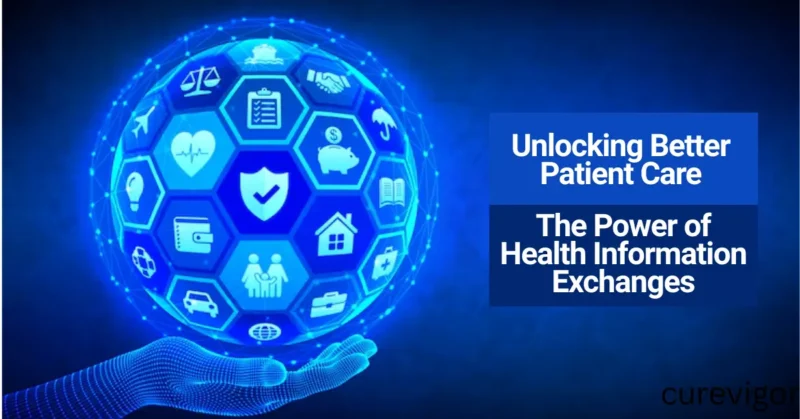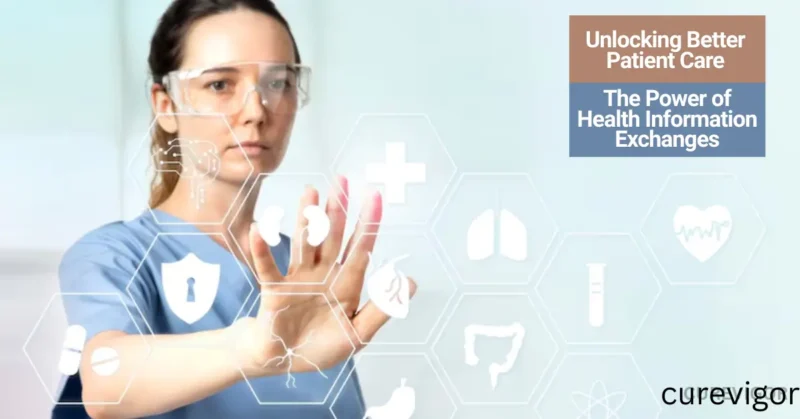Unlock the potential of Health Information Exchanges (HIEs) in modern healthcare. HIE facilitates the sharing of electronic health information across organizations, enhancing care coordination and breaking down barriers.
Thank you for reading this post, don't forget to subscribe!Health Information Exchange (HIE) is more than a trend—it’s a critical infrastructure for advancing patient care, enhancing clinical decision-making, reducing costs, and improving health outcomes. As healthcare systems move toward digitization and interoperability, understanding and leveraging the full potential of HIE becomes essential.
What Is Health Information Exchange (HIE)?
Health Information Exchange refers to the secure, electronic sharing of patient medical records across healthcare organizations. This ecosystem connects hospitals, primary care providers, specialists, labs, pharmacies, and public health systems to ensure the right data reaches the right provider at the right time.
What are HIEs?
HIEs are secure platforms that facilitate the electronic exchange of patient health data across different healthcare settings. The records include medical records, lab results, medication lists, and immunization records. By breaking down these data silos, HIE enables:
- Improved coordination of care: Providers gain a more holistic view of a patient’s medical history, resulting in more accurate diagnoses and treatment plans.
- Enhanced patient safety: HIE prevents medication errors, duplicate tests, and adverse reactions by alerting providers to potential conflicts or allergies.
- Streamlined administrative processes: Patients can access their records easily, reducing paperwork and administrative burdens for healthcare providers.
- Public health insights: Health Information Exchange (HIE) can collect and combine health data from different sources to improve disease prevention and management.

Key Benefits of Health Information Exchange in Modern Healthcare
- Patients: improved access to their health information, empowering them to participate in their care decisions.
- Providers: better patient care, reduced errors, and enhanced workflow efficiency.
- Payers: more accurate claims processing, reduced healthcare costs, and improved population health.
- Public health agencies: enhanced disease surveillance and outbreak response
Enhanced Care Coordination
HIE enables seamless access to a patient’s comprehensive medical history, regardless of the originating provider or institution. This continuity reduces fragmentation and ensures consistent, informed treatment plans.
- Streamlines patient transitions across facilities
- Instant access to lab results, imaging, and medication history
- Minimizes duplicate testing and medical errors
Improved Patient Outcomes
HIE significantly contributes to more accurate diagnoses and treatment plans through timely access to comprehensive patient data. This process directly improves patient health outcomes. Accessing a patient’s medical history in real-time allows healthcare professionals to make well-informed decisions about their care.
Real-Time Decision Support for Clinicians
Clinicians can make better, data-driven decisions if they have real-time access to patient information. Alerts and updates integrated into EHRs via HIE reduce adverse drug interactions and diagnostic errors.
- Clinical notifications that are automated for allergies and contraindications
- Guidelines based on evidence that are included in data pipelines
- Support for risk assessment and predictive analytics
Improved Medication Administration and Patient Safety
By giving doctors access to full prescription histories and avoiding overprescriptions or dangerous drug interactions, HIE lowers medication mistakes.
- Unified medication reconciliation
- Early detection of substance abuse patterns
- Controlled substance monitoring across providers
Faster Emergency Care Response
In emergencies, Health Information Exchange (HIE) provides first responders and emergency room teams with instant access to critical data such as allergies, chronic conditions, and previous interventions, eliminating the need to wait for paper records or rely on patient memory.
- Reduces time-to-treatment in trauma or stroke care
- Improves triage accuracy and prioritization
- Life-saving insight into unconscious or incapacitated patients
Cost Savings
One notable advantage of HIE is its ability to reduce redundancies in testing and treatment. HIE helps lower the cost of care delivery by reducing unnecessary tests, procedures, and administrative burdens. Streamlined workflows also improve operational efficiency.
- Lowers claim denials due to missing information
- Avoids redundant diagnostics
- Cuts down on data-entry duplication
Security and privacy concerns
While the benefits of Health Information Exchanges (HIEs) are established, they also present important security and privacy challenges that must be addressed. To mitigate these concerns, robust security measures must be implemented in the design and operation of HIE.
Advanced encryption techniques are crucial for safeguarding sensitive patient information as it is transmitted and stored. This ensures that even if data is intercepted, it remains unreadable to unauthorized users. Additionally, strict access controls must be enforced to limit who can view or modify patient records. By employing role-based access controls and multi-factor authentication, HIE can further enhance the security of patient information.
Moreover, continuous monitoring and regular audits of the systems can help identify and rectify any vulnerabilities or breaches that may occur. Educating healthcare professionals about the importance of these measures and best practices for data handling is also vital in maintaining the integrity and confidentiality of patient information. Overall, a comprehensive approach to security is necessary to protect patients’ private health data within HIE.
Challenges and Opportunities for Health Information Exchanges
- Data privacy and security: A padlock with a question mark representing the need for robust safeguards in HIE.
- Standardization and interoperability: Puzzle pieces of different shapes and sizes trying to fit together, symbolizing the challenge of data compatibility between other HIE systems.
- Advancements in technology: A futuristic cityscape with connected healthcare devices, depicting the potential of technological advancements for HIE.
- Adoption and expansion: A map showing HIE coverage growing across a country, illustrating the need for broader adoption to maximize its impact.
While HIEs offer tremendous potential, challenges remain. Robust safeguards and patient consent protocols are necessary to address data privacy and security concerns. Standardization of data formats and interoperability between different HIE systems are ongoing efforts.

The Future of HIEs
Health Information Exchanges (HIEs) are poised to play an increasingly vital role in the healthcare landscape as technological advancements continue to unfold. With the incorporation of artificial intelligence (AI) and machine learning (ML) technologies, Health Information Exchanges (HIEs) are anticipated to greatly improve their data analytics capabilities.
By harnessing these advanced technologies, HIEs can analyze vast amounts of health data more efficiently, uncovering patterns and trends that may not be easily identified through traditional methods. This enhanced analytical power will provide healthcare professionals and organizations with actionable insights, facilitating better-informed decision-making. For example, AI-driven analytics could help identify at-risk patient populations, improve treatment plans, optimize resource allocation, and ultimately lead to improved patient outcomes.
As HIE evolves with these technologies, they will become essential tools for healthcare providers, enabling them to deliver more effective and personalized care while addressing challenges such as cost management and patient safety. Health Information Exchanges (HIEs) will significantly advance patient care and overall healthcare system efficiency in the future.
However, the future of HIE is bright. Technology and data governance advancements pave the way for secure, seamless health information exchange. Adopting HIEs nationwide can revolutionize healthcare delivery, improving quality, safety, and cost-effective care.
Conclusion on Health Information Exchanges
HIEs are not merely technological solutions; they represent a fundamental shift in managing and utilizing healthcare data. Collaboration and information sharing can improve healthcare delivery for patients and professionals.
In modern healthcare, health information exchanges are essential for collaboration, improving patient outcomes, and contributing to an efficient and cost-effective healthcare system. Overcoming challenges related to security and interoperability is crucial to unlocking their full potential.
FAQs on Health Information Exchanges
Q. What is the critical role of health information exchange?
Health Information Exchange (HIE) enables healthcare professionals to securely and quickly share patient data. This improves treatment decisions, reduces medical errors, enhances care coordination, and eliminates unnecessary tests. HIE plays a crucial role in making patient health information readily accessible, ultimately leading to more patient-centered and efficient healthcare.
Q. What is the role of HL7 in the exchange of health information?
HL7 (Health Level Seven International) is a set of standards to facilitate electronic health information exchange. It establishes protocols for how data is formatted and transmitted, ensuring that different healthcare systems and applications can communicate with each other seamlessly. HL7 enables interoperability across healthcare organizations by ensuring that data is structured consistently.
Q. What is the directed exchange model of health information?
Specific health information is safely sent and received between known organizations, such as healthcare providers, through directed exchange. This method is frequently used to ensure that patient data follows patients along the continuum of treatment by sending test results, referrals, or discharge summaries across facilities. Such a point-to-point paradigm, which depends on trust connections between the sender and recipient, is comparable to secure email.
Q. How do health information exchange models impact data analytics?
HIE models provide access to large, integrated datasets from multiple healthcare providers, enabling more comprehensive data analytics. Instant access to patient data improves trend analysis, outcome monitoring, and data-driven decision-making in healthcare systems, leading to better population health management, the detection of service gaps, and more precise forecasts in healthcare analytics.
Q. What is HL7’s role?
HL7 plays a crucial role in the healthcare landscape by establishing comprehensive standards that enable the integration, sharing, and retrieval of electronic health records. These meticulously crafted standards act as a vital bridge, allowing healthcare practitioners to access and leverage patient data effortlessly.
By ensuring smooth and efficient communication across diverse healthcare systems and organizations, HL7 empowers clinicians to focus on what truly matters—delivering exceptional quality of care and improving patient outcomes. The seamless interchange of clinical information transforms the way healthcare is delivered, fostering collaboration and enhancing the overall patient experience.
Read more articles on Optimal Health Tips.
You might like to read:

